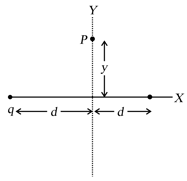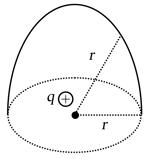MEDIUM
JEE Main/Advance
IMPORTANT
Earn 100
In the following figure, the electric field on axis will be maximum at


(a)
(b)
(c)
(d)
82.35% studentsanswered this correctly

Important Questions on Electric Charges and Fields
HARD
JEE Main/Advance
IMPORTANT
Figure shows charge beads with charges as shown in figure. The charges are placed upon the corners of a square. Rank the magnitude of electric field at the centre in decreasing order.

MEDIUM
JEE Main/Advance
IMPORTANT
A wire is bent in the form of a regular pentagon of edge length . A total of charge is distributed over it. Find the electric field at the centre of the pentagon.
HARD
JEE Main/Advance
IMPORTANT
A point charge is kept at the centre of a fixed semicircular thread having a uniform charge per unit length , the radius of the semicircular thread being . The force required to keep the charge stationary is
EASY
JEE Main/Advance
IMPORTANT
In which of the following figures, the direction of electric field at point is different from others? and represent constant linear charge densities)
EASY
JEE Main/Advance
IMPORTANT
A circular ring carries a charge , the variation of electric field with distance measured from centre along axis for can be given as Radius of Ring]
EASY
JEE Main/Advance
IMPORTANT
A circular ring carries a charge , the variation of electric field with distance measured from centre along axis for is given by Radius of Ring]. The maximum electric field on the axis will be [where ]
MEDIUM
JEE Main/Advance
IMPORTANT
A region of space contains a constant electric field of magnitude, . A wire frame forming a square, on a side, is placed in the region, oriented so that the perpendicular to the plane of the square makes an angle of with the field. What is the magnitude of the electric flux through the frame?
MEDIUM
JEE Main/Advance
IMPORTANT
A charge is placed just above the centre of a horizontal circle of radius , and a hemisphere of this radius is erected about the charge. Compute the electric flux through the closed surface that consists of the hemisphere and the planar circle. Do not use Gauss' law.

